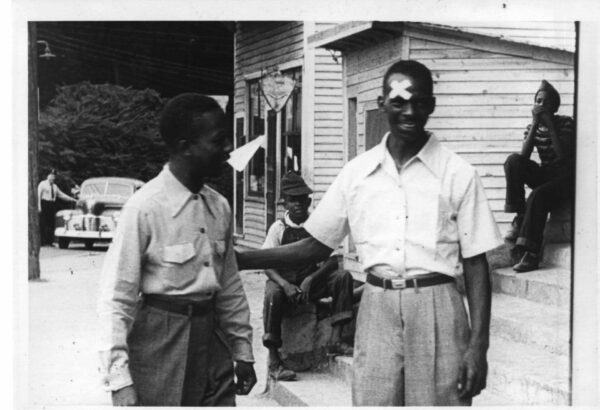
Exterior scene of “Pitch a Boogie Woogie” shot on steps of Plaza Theater, with Ma Bell’s in background.
“The Block,” Filmore Bells says, “was about two blocks long”– on Albemarle Avenue from Virginia Street to Bonners Lane. His daddy, Grant Bell, ran a restaurant that, with its next door neighbor the Plaza Theater, anchored Greenville’s Westside business district from the late 1920s into the 1960s. Filmore Bell speaks like the neighborhood historian that he is, factually emphatic in his memories, expressive with his hands. He tells great stories and enjoys an audience. “I’m a talkative fellow,” he’ll slip into one of his later quick narratives, full of asides. He punctuates many of his sentences with “what not,” as almost an apology that he’s not going on and on about the topic at hand–several times in transcripts of his interviews for the UNC-TV documentary Boogie in Black White, you’ll see “blah blah blah” or “lots here that we can’t use” and once, “I tried to keep going with this because it was interesting but it just can’t be used.” [Those raw tapes are in ECU’s special collections]. When he’s listing, he’ll look up and slightly away like he’s reading names or places off a scroll. “There were businesses on both sides of the street at that time,” he continues, “and the businesses were Bell’s Restaurant, the Plaza Theatre, the Pythian Hall, Paradise Cafe [which he pronounces ‘calf’], Shiver’s Shoe Shop, and City Pool Room, Quality Eastern Oil Company, and the Red Rose Club–it was about the liveliest.”

Map of The Block created by UNC-TV staff artist, 1987. ECU, Joyner Library Special Collections.
“The Block was jumping, as you say,” E.H. “Red” Eaton explains. “People was out, enjoying theyself. There wasn’t a lot of fighting going on. We had, at that time, we had one officer would walk up and down the Block, and that was all. And there was no fear. You could sleep on your porch or anywhere you want to. There’s nothing like it now. It was like, you could sit down anywhere and you didn’t have to worry about nobody bothering you. But you better not sit down and do that now.”
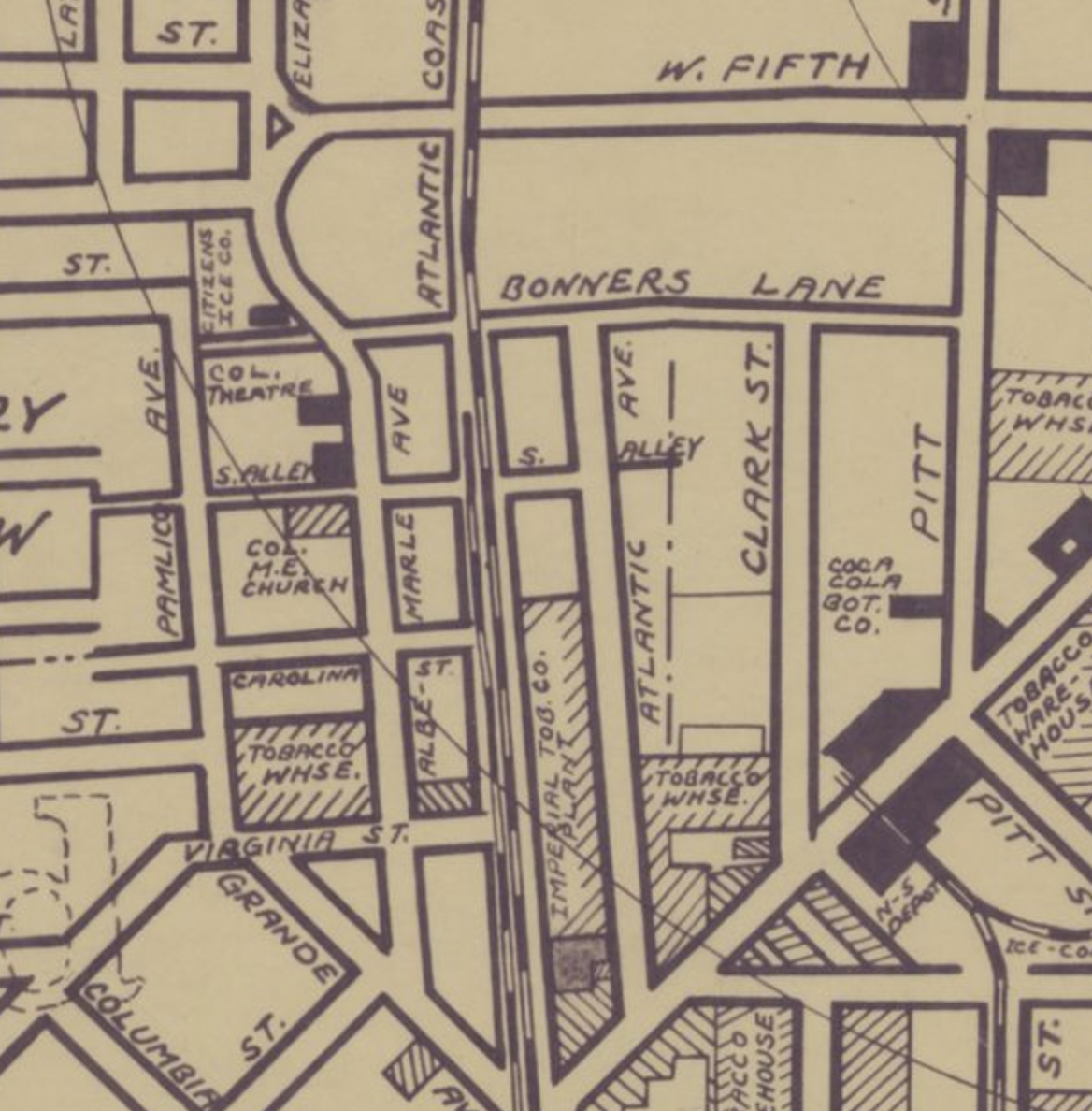
Detail from map of Greenville, 1933. ECU Digital Collections.
• • •
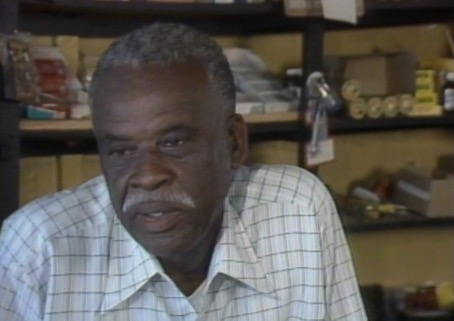
Filmore Bell in his Albemarle Ave. grocery, 1987. UNC-TV.
Filmore Bell was a young man during the Block’s formation, and by the time he entered the U.S. Army during World War II, its reputation as a great place for music, musicians, shows, and fun had grown. Mattie Sloan, a manager with Winstead’s Mighty Minstrels, recalled it as “a young New York town.” Willie “Ash Can” Jones, a dancer with Irvin C. Miller’s Brownskin Models, loved playing Greenville, visiting, hanging out before and after shows or between them, and if he were close enough at any layover to get to Greenville, he’d be there; he secured several musicians and dancers in Greenville for acts he was managing while traveling through the region, although he wasn’t sure who was from there or who might have been stranded there by a different show. Without prompting in his Philadelphia home in 1987 , he vividly described Ma Bell’s hospitality and food.
The Block was liveliest on weekends but it also hosted concerts by some of the biggest touring national recording Black artists–usually at the Star Warehouse on 9th Street but also in tents on the Block or, occasionally, in the Plaza–whenever they might be scheduled according to a traveling act’s tour. I ask Bell who he remembers from those shows. He says,
There were so many: Earl Fatha Hines, Tiny Bradshaw, Andy Kirk and the Clouds of Joy with Mary Lou Williams, and out of Charlotte you had Jimmy Gunns, you had the Carolina Stompers out of Wilson, you had the Blackhawks out of Kinston, the Puff Stompers out of Elizabeth City and the Sunset Royal Entertainers out of St. Petersburg, Florida.
William “Geechee” Robinson, the clown trombonist who grew up in the Jenkins Orphanage and toured extensively with Don Albert and Duke Ellington, played Greenville several times with Silas Green from New Orleans before settling in Wilmington, where he had his own bands and ran a nightclub. Especially prior to World War II, he says, some of those acts may have been imposters: “Before t.v. and all that,” he explains, “people didn’t necessarily know what a star looked like, so if you had a band that could play somebody’s hit just like it sounded on the record, well, you could be that star! And who would know you weren’t?”
Filmore Bell describes what he calls “the warehouse days”:
At that time it was segregation; they would have a rope running midway of the warehouse and one side would be for white and one side for coloreds. But sometimes some would go under the line and here would come the police and run ’em back where they’re supposed to be at. That’s how the warehouse days were. And they would have the stage midway between both lines, and that’s the way it was.

Red Eaton in his Albemarle Ave. Shell Station, 1987. UNC-TV
Red Eaton says he only went to one warehouse show:
I remember the night Earl Hines played here–it was the Star Warehouse out on Ninth Street. I was on the inside and I heard somebody fussing, heard somebody cussing, and somebody started, well, they shot. The pistol sound went off. I looked around and everybody started running. And I started running, too. I didn’t go to the door–I went to a window and went out a window. And I stoled out and found my way home.
Millard Filmore Bell’s parents, Grant and Rosa Bell, began selling stew beef, rice and peas–several recall Grant Bell as “the stew beef king”–on Atlantic Avenue beside the Imperial Tobacco Factory and Warehouse, shortly after World War I. They bought a lot on Albemarle Avenue in 1920 and built their first restaurant there in 1925. The Plaza Theater was built next door soon after. Through the Depression, the Block remained principally the Plaza, Bells’, the AME Zion Church, and the Pythian Hall. Bell said the building most everyone recalled as Bells’ was their second, the first having burned down in 1935, when he was 16.
Charles Shivers developed one of the first of the “new” businesses, opening his shoe repair shop in 1939; he said that most of the buildings that became the Block, like his, were moved there from elsewhere.

Louise & Charles Shivers at home in Greenville, 1987. UNC-TV.
Charles and Louise Shivers also had precise memories of the Block and its environs. They are both well-spoken and polite, and funny in ways that come out subtly as we talk in their living room–he’s mostly dead-pan in a low bass, she a bit mischievous, her voice on occasion lilting. He especially is sometimes more brave than bitter, as he might have been when he matter-of-factly tells the story of how he got his first shoe shop, so perfectly understated that its power is not easy to catch at first. It could not have been delivered better had it been rehearsed; perhaps it had been.
When I started on the Block, it was a result I was employed downtown in the shoe shop, and it happened I had fixed some shoes for Mrs. Meadows, she was wife of the President of East Carolina University [Leon Renfroe Meadows, ECU’s second president, served from 1934-1944], I repaired a pair of shoes for her, but at that time we couldn’t face the white customers in the shop, and the other white employee waited on her, and she compli- mented the work so much, the work that I did he got credit for, and this got me so upset I told my grandmother [Pattie Elizabeth Kearney] if I could do work like that to please the wife of the president of the university, then I could make a living at it and if she didn’t make some arrangements for me to go into business, I was going to leave town, so she got to work, and she got Mr. W.C. Cox, she talked to him, he owned the property out there [on the Block] and there were some vacant buildings down where the warehouse is now. He bought that building and had it pulled up there with the turnstile and the mule and so forth and they rolled it up and set it up there and that was the only building in this area at the time. So it had two little windows on the front—that’s when I went into business—that was late 1939. I operated it util I went into service.
Almost like a set up routine, Louise tells her Block story, straight-faced and near-perfect in its details, and at its beginning, a little odd: “I was one of the first persons to work on the Block in a beauty shop. It was called Midgett’s Beauty Shop. I operated the shop, and Charles had the shoe shop next door, and there was a little peep hole through his shop I didn’t know was really there. He could look through this hole and see a few things that were going on in the beauty shop. And we had about five or six booths in there. One of the girls, Mary Louise Butler, she’s dead, the late Mary Louise Butler, said I think you’re getting a secret admirer. I said What you talking about? She said, I think Charles Shivers is looking in that peep hole at you. Am I right? [She looks at Charles and smiles, and it looks like he’s a little surprised by this memory, too.] And from then on, we started a little courtship—we had been knowing each other all along.”
Charles tries to re-take control of the narrative: “There was a party, that’s when we started going together—”
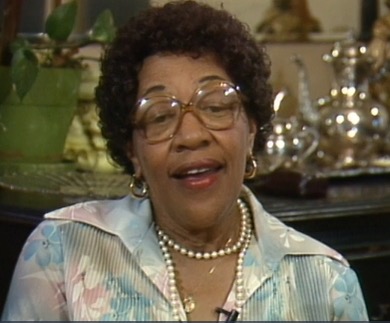
Louise Shivers in her Greenville home, 1987. UNC-TV.
Louise interrupts and imitates Charles: “I know who I’m taking to the party tonight” and switches back to her voice, “My birthday party—and sure enough, he was at my door knocking, that was 1940. We didn’t court long before we married. It was ’41.”
She adds:
When Earl Hines and Mary Lou Williams came back for the second time, not the first time, I did Mary Lou Williams’ hair, and this girl who worked in the shop with me at the time gave Fatha Hines a manicure. And we were very elated over that, because the people were all on the outside looking to see what was going on in the beauty parlor, because they thought we were really something to be able to do the celebrities’ hair and manicure.
I ask her about Mary Lou Williams.
She was a very pretty girl, and she had very very long hair. I had not been really accustomed to doing hair that long. It was pretty at the dance, and she was very happy, because she said in the North, she couldn’t get the type work she was getting in North Carolina.
Some traveling shows performed in tents on the Block, or in the Plaza, which also hosted talent nights, beauty pageants, boxing matches, and vaudeville shows like Irvin C. Milller’s Brownskin Models. Filmore Bell says:
Winstead’s Mighty Minstrels, when they came to Greenville, it was put up on the Block, at the site where the Roxy Theater is now. But Silas Green, they had their special trains they would come to Greenville with and they would put up on Tenth Street, and when Silas Green would come to town, they would have big parades on Main Street, Dickinson Avenue and Evans Street. Silas Green’s was the best–they had the prettiest girls and what not.
Despite being called a “minstrel” show, Winstead’s wasn’t much different from Silas Green from New Orleans, which wasn’t much different from Irvin C. Miller’s Brown Skin Models: they were all traveling vaudeville shows with pretty women in a chorus line, a good band, a couple of comics, and a variety of vaudeville acts. One of Winstead’s best known was the mentalist Joe Frazier, of whose act Bell says repeatedly, “I don’t see how it was done, but it happened,” almost daring you with each assertion to doubt him.
But like the excellent storyteller that he is, Bell warms up his audience with a lesser Joe Frazier tale that begins with a question about what else he remembers about acts on the Block. “Richard Hardy got hypnotized in a store window,” he says, deadpan, “and he stayed hypnotized for about seven days.”
Who did it? I wonder.
Joe Frazier. Joe Frazier was somebody who came to town, and he hypnotized Richard Hardy, he hypnotized him for seven days. It was an advertisement for his show and to bring people into the clothiers, too. Yeah, Joe Frazier. Joe Frazier was buried underground for about two weeks, and he didn’t have nothing sticking out of the ground. He was buried in a coffin and didn’t have nothing sticking out of the ground except a pipe. I don’t see how it was done, but it happened.
What made him come out? I ask.
Well, he just was going to stay for two weeks, and that was it, that was long enough, I guess, too long for me.
Bill Myers, who founded the Wilson band the Monitors in the 1950s, virtually grew up on the Block, on Bonners Lane. He played at the local clubs while a student at Eppes High School, where a couple of bandmasters helped him along, but his most important lessons came from performing with Winstead’s Mighty Minstrels, which he joined whenever they were in town for their Greenville shows.
I had met Mr. Myers a few times over the years before we sat down at the Freeman Round House in Wilson to talk more formally about his early days in Greenville. He said he got picked up to play with Winstead’s becasue of the reputation he’d earned while still in high school, and also because of a neighbor who traveled full-time with Winstead’s band. “We’d get on a truck and drive around Greenville, he said, “and then we’d go out and play in front of the tent. I Learned the importance of listening from playing with them. You listen to what they’ve said, and then you know to play in harmony next time he does that same statement.” He said that he considered going with Winstead’s when they left town to continue their tour. He doesn’t recall today the full name of his saxophone-playing neighhbor who tried to recruit him for the band: “Diddy was full time with them, he said you need to get with them, but it was a hard life–I knew that–he traveled with them all the time, full time.”
Wilson native Sam Lathan, who played drums for the Monitors for most of their 66 years of performing, had a similar experience and lesson, also from Winstead’s. When they played Wilson, he recalls, an advanceman known as ‘Bug Eyes’ would always look for him and hire him to help set up the tent and then to play drums during the show. It was with Winstead’s, he says, that “I learned how to listen to the other performers around me and how to complement what they were playing–not compete with them. That’s really where I first learned to listen.”
• • •
After World War II, action on the Block picked up with the return of veterans and a booming economy. Two clubs were its anchor, the SS Tropicana and the Red Rose. Louise Shiver says, “It seems they would come from the Red Rose Club, they would make a path to Bonners Lane, coming from the Red Rose Club and to Bonners Lane from the Tropicana Club, and they’d have a good time there and they’d make a beeline to the Red Rose Club back on the Block, so it was just going backwards and forward to see who was who and who was there and when. And it has been known they would stay at the Tropicana till 3 in the morning ‘cause the lights then would kind of dim, that’s what we called the after-hour club, ’cause they didn’t open till 8 or 9 o’clock.”
Charles Shivers adds:
Eventually Mr. Cox expanded and built one or two more places there, Wet Wilson’s cafe and a pool room joined together. Most of the buildings were moved there from elsewhere, you know, and they refurbished them, and that’s where several black businesses were congregated there, and it got the name the Block, and that’s where most of the younger people congregated at that time. They had the pool room, a beer joint, a shoe shop, a beauty parlor. Later on, Drum’s Hatchery was located there—they had chickens.
Louise Shivers says, “Further down the street at the corner, the cafe–“
Charles says, “Eventually Captain B. Willie and his two sons opened a oyster bar, they served oysters on the half shell, and across the street was Rainbow Cleaners and Laundry and farther down was the lot where the minstrel shows and so forth came down, and the next building was the National Biscuit Company. That was the extent of the Block.”
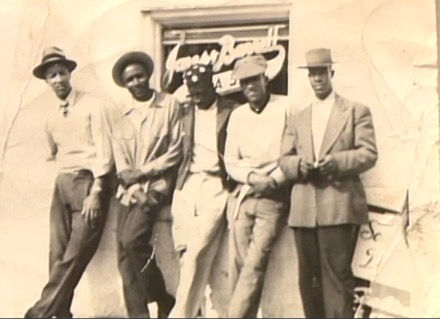
Hanging out on the Block, courtesy of Louise Shivers.
Filmore Bell starts remembering who’d be out: “A lot of them are deceased now, Roy Little, Jackson Atkinson, Baby Tucker, Edward Thompson, Charles Bell, Prince Hemby, Charles Shivers, just a number of people, I just can’t keep calling them, just so many.” And he also says in a quick run-on list where, in Greenville, these folks lived: “Newtown, downtown, Riverdale, Bonners Lane.”
Louise Shivers recalls the Tropicana: “The decoration theme was a ship, the S.S. Tropicana was the name of it, it was painted up so you had the feeling you were on the ship the SS Tropicana. It was a family affair. I helped her run the nightclub business. The only thing we had was a juke box, most of the entertainment was music and soft lights and alcoholic beverages. We sold beer, we had a beer license, but we bootlegged a little bit of bourbon, and that’s what it was all about. Saturday and Sunday was the only time we did any business that came to anything. And the youngsters enjoyed it–it was an outlet for them. We had a strict rule for school kids: when they got their diploma, they could come in, but not until, so on graduation night, they’d all flock to the Tropicana with their diplomas in their hands.”
Pitch a Boogie Woogie co-star Herman Forbes says that his parents kept him away from the Block. He was for the most part kept at home, away from influences outside the family’s church. He says, “I didn’t get to the Block until I was a senior in high school. All the other times i got out, I was going to church, to Sunday school, prayer meetings, that sort of thing. The only fun I got out of that was sometimes leaving church, after a prayer meeting, we would go by Busy Bee and get a hot dog. That was just fine for me.”
I ask him if he felt restricted in his growing up.
“Well, that’s all I had known,” he says. “I was a pretty good boy–they didn’t have to get me much.”
I wonder if he heard stories of the Block.
That’s what used to make me real sick. Everybody was talking about what was happening on the Block and that sort of thing, and of course, I’d nod my head like I knew what they were talking about, but I hadn’t seen the Block–I didn’t know what was going on. And then when I finally got to go to the Block, I found out I didn’t miss anything. I had the seen the same fellows at school and passing my house to go out to play baseball, and that’s the only thing–but I hadn’t really missed anything.
Multi-instrumentalist Bill Myers, who co-founded the renowned Wilson-based band the Monitors in 1956, had a very different experience growing up in Greenville. He worked at Bell’s Restaurant as a kid and had a seat with his name on it at the Plaza Theater. He began playing music in clubs on the Block before he was old enough to be a patron.
Myers grew up on Bonners Lane, raised by his grandmother, and one of his earliest music influences was a saxophone playing neighbor he recalls only as “DB,” who traveled with the Winstead’s Mighty Minstrels band. Myers was at a perfect age for his experiences as he learned music and explored the local night life as a young teenager on the Block to have them become such clear memories.
He lays it out:
The Block was the business center for the Black community and you had the ice house on the corner, the cab station, the auto repair, Bell’s Barbecue, the Plaza theater, the barbershop, York AME, the cleaners, and then across the street, the seafood restaurant, the shoe shine shop, the pool room, the beauty parlor, the shoe repair, Wet Wilson’s, Red Eaton’s–it was the center, everything that happened on the block, I there, I was out there, every day. and on Sunday, you had to put on a suit, you go out there and stand, watch people walk by, just smiling.
Lena Cherry, organist at York AME Church, was his first piano teacher. “I went there because it was on the Block,” he says. “It was handy. If it had been a Baptist church I’d have gone there. So she became my first music teacher. She lived in New Town and I had to walk, it cost 50 cents a lesson, and sometimes I’d go to the movie instead. It only cost 8 cents.”
He describes his relationship with John Warner:
I was one of Mr. Warner’s best customers–he let me in free sometimes. I had my own seat. I mean he put my name on the seat. First row, first seat. Somebody sat there, he would get him up from my seat. That was my seat. He’d take me over to his house, several times, and in those days, that was unheard of. He’d feed me, all that stuff, and we got very close.
Myers especially loved the cowboy movies and the actors that visited: “Mr. Warner would have shows all the time. Johnny Mack Brown would come in and do a roping show [Brown was also an All-American football player at Alabama], Sunset Carson came to town, Bob Steele, I used to meet all of them.” [Watch Sunset Carson Rides Again, from 1948].
But even as he began to play in bands on the Block, Warner told him he was too young to be in “Pitch a Boogie Woogie”—-he had just finished his freshman year at Eppes High School the summer “Pitch” was made.
Myers played music with whomever he could. Whenever Winstead’s was in town, he’d join the band for a drive around town performing on the back of truck, and then at a parade and concert before the first day’s show–Winstead’s usually played multiple-night stands, sometimes a week in one town. He’d always get sent home before a Midnight Ramble but would usually go to Bell’s Restaurant instead.
He loved performing on the Block, the people he met and the clubs he played: the Cavalier [not on the Block but nearby, on Fifth Street], the Tea Room, the Red Rose and the Tropicana, which was his favorite. “Bob Shiver [Charles Shiver’s brother] had been to New York and majored in art,” Myers says. He had all these artistic ideas, palm trees and all–it was the prettiest of the clubs, but you had to go up those steps up there. It had a nice bar and a little stage in the corner.”
Wet Wilson’s was a small juke joint with a popular cafe, run by Sylvester Wilson, but by far the main attraction on the Block was always Bell’s Restaurant.
Charles Shivers recalls the proprietor:
Grant Bell was a marvelous person, nobody went hungry, I mean if you didn’t have any money, you could go there and get a meal. Of course it didn’t take much money to get a meal anyway. He was known as the Stew Beef King. He served you stew beef and rice for 15 cents and you could get a belly full—you wouldn’t leave there hungry. Grant really fed a lot of people in this area.
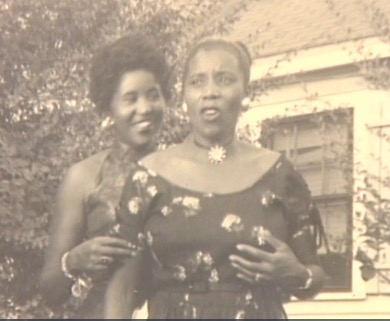
Louise Shivers and a friend. Courtesy of Mrs. Shivers.
Louise Shivers smiles broadly as she remembers:
You could go to Bell’s Cafe and get a sausage sandwich for 5 cents and then he would keep a big pot of gravy he would put over there and he would dip this sausage sandwich in the gravy, and say ‘It’s good, eat it.’ 5 cents, 10 cents, if you got a 10 cent sausage sandwich you had a meal. Plus he made what you used to call heavy bread, bread pudding, and you could get a big slice of bread pudding for a nickel and then buy a 5-cent Pepsi Cola it would carry you through the day. You had nothing to worry about ’cause you would be really filled up. All this, the kids really laugh about it now but it was so very very true. All at the cafe, they were very fine people.
Bill Myers explains his job at Bell’s:
I worked in the front part, not cooking, he did that. I would sell chewing gum and cigarettes, snuff, chewing tobacco. I worked the register–it was my first job. On my first day, Mr. Bell said, ‘I trust you,’ he said, [and Myers grabs my arm like his was being grabbed way back then and pulls it close] ‘and ’cause I trust you I’m going to show you how to work this cash register. We had ice cream, too, I’d scoop that up. We’d sell anything, handkerchiefs, what not.
Charles and Filmore Bell did the cooking with their dad, Grant. Charles was the youngest–they were the cooks. They lived upstairs. They had a balcony, and we’d go out and watch folks down on the street. Then after the late shows [at the Plaza or in a tent] we’d be open late for everybody.
John Warner’s Plaza Theater was the second mainstay of the Block, and you get a glimpse of its steps and the exterior of Bell’s Restaurant near the beginning of “Pitch a Boogie Woogie.” He left two interior photographs with his attorney, for insurance purposes. It had become home to mischief before it collapsed in the early 1970s. Purvis Cohens says it had become so dilapidated that the large ceiling fan used to cool it collapsed the r00f, and that was its end. I’ve not found an exterior image.
About the time “Pitch” was made, John Warner’s centrality to the Block community was diminished greatly in what was often referred to simply as “the incident,” which ultimately also changed the face of the Block. In summary, Warner’s Plaza was boycotted in about 1950 to the point of closure, and the Roxy was built and opened across the street, without anyone locally knowing that Warner was the Roxy’s silent partner.
Almost everyone I spoke with recalled the event, but no one had a better grasp of its nuances than Purvis Cohens, who first was projectionist and manager for the Plaza. He says that a Jewish man named Haley “bought John out–but he didn’t really buy him out”–just a 50% interest. From Reidsville, Cohens came to Greenville to manage Haley’s interest in the new Roxy.
Cohens describes “the incident”: “A local fellow went into the theater one night to get his girl out, and there was a scene developed, and John called the cops. Well, there wasn’t anything but wWites as policemen back then and they came and got the fellow, he’s still in town now–and arrested him, roughed him up a bit, t think he got six months, too And the Black community boycotted the theater. It got so hoodlums would stand out front and beat ’em up, the people that went to the movies.”
Because Warner left with the police and the unruly patron, his role in what continued to unfold was not clearly known but certainly suspected throughout the Black community.
Charles and Louise Shivers fill in the story:
Charles: That was sort of tragic for Mr.Warner. He was a strict disciplinarian, he tried to maintain order in the theater and it seems that one of my good friends was there one night and got sort of disorderly and they had a policeman to come in and arrest him, and he sort of beat him up and mutilated him a little bit, and from that incident whether or not Mr. Warner was responsible, he lost favor with his patrons, and the business started turning, and it was sort of an unspoken thing, and they boycotted the theater, the word circulated, Don’t go to the theater on account of the incident and people just quit going to the theater. That was the demise of the Plaza.
Louise: We would watch from the beauty shop, we would really watch who was going there. They were having some very good pictures at that time and we wanted to go but we wouldn’t go, and there was some people who were still going to the movie.
Charles: Probably somebody didn’t know about the incident.
Louise: Some of the ladies would come over to the beauty parlor and say What’s happening? No body’s going to the movie anymore and we’d have to tell them what happened. One lady said, Oh I didn’t know that—I wouldn’t have gone. Because it’s a small town, it’s true, but the word doesn’t get out on everything.
The Roxy Theater was built then across the street, Warner maintaining an interest in it and in the Block; the Plaza fell down. Bill Myers’ says that the Block continued to thrive into the 1950s–he was performing there when he learned of a job opening as band director at Elm City High School, which he would accept in 1957 and where he would remain until he retired.
He tells it:
My dad came into the Cavalier Club one Sunday night and said ‘I have set you up for an opportunity.’ Johnny Wooten said I could take his car, a big old white Buick. I didn’t plan to stay if I took got this job–I was going to be a musician. So I found Elm City [in 1957], and the principal hired me on the spot. I made it clear it was going to be one year. But I got hooked up in education and all those kids, they had nothing but sharecropping, but without condemning it, I wanted to show them there was a whole lot in the world. Kids never been to the ocean, kids never been to Raleigh, never been to a movie. So I stayed.
On the Block, Wet Wilson died, the Plaza was gone, the Roxy barely open. The Block was virtually a ghost town in the 1960s.
Bell’s, the first of the Block’s retail businesses, was also among its last. The Shivers, Red Eaton and Filmore Bell all agreed that the Block did fine into the 1960s, but as in much of the rest of the country, as previously Whites-only businesses opened their doors and society became increasingly integrated, Black business districts began to fade. The Roxy had already ceased operations as a theater before John Warner died in 1972.
Then, about 1975, a group of Greenville artists led by Bill “Shep” Shepherd, a singer and band leader–his rock n reggae band the Amateurs was among the region’s most popular during the last decades of the 2oth century–rented the Roxy from William Nobles, cleaned it out, and began hosting arts events.
Shep explains:
When we got to the Block, it was hardly anything there. The theater was abandoned, and there was an air of sort of static. It wasn’t really improving, it was just kind of there. People drove through. Mrs. Bell and Mr. Bell were the only restaurant except Benny Rountree‘s and those were good. Mrs. Bell was happy to see something happening at the old theater. It had been abandoned. She fed people who didn’t have any money, she fed the people, and every now and then there were people who would come and order food and pay her later–we were part of that crowd.
I had dropped out of college and I wanted to continue being involved in the arts, I liked music, and I had some friends that liked that sort of stuff, and I saw that abandoned theater as an outlet–a place to play music and a place for people I knew who did pottery to come in and display their works. At the time, there was no arts council in Greenville. So a lot of us who wanted to find an outlet for our talent saw the theater as a place where we could get some things going and do some activities on our own.
The theater got going pretty well with this sort of alternative thing we were doing. People were literally forced to communicate with us. We were pretty avant garde for the time, hippies and Blacks moving into this theater to do alternative stuff, cultural stuff. We wanted to do some things we thought were new, like plays and poetry readings and we had no idea that this kind of creative thing had been going on through Mr. Warner, so it was kind of a rediscovery of some things, kind of like deja vu in a way, to learn he had been making movies here, that this kind of spirit, if I can use the word, was already here when we walked in to the theater.
Shep and his friends produced and hosted gospel and folk concerts, poetry readings, art shows and sales, parties and informal gatherings; their last was a Halloween Ball in 1981. Bennie Roundtree’s restaurant, Eaton’s garage, Filmore Bell’s little grocery, a taxi stand, and an ice house continued on for several years. It’s now mostly vacant lots again.
• • •
I regret that I did not find reason to remain in contact with folks like the Shivers and Filmore Bell. Charles Shivers called me once, after Louise had died. The city wanted his house, he said. It had been his grandmother’s, built about 1900, where Princess White and Witty & Wiles and other once-renowned Black vaudeville stars had stayed for the night because Greenville had no public accommodations for Blacks except for private residences like his–and the recently disappeared place at the corner of Memorial and Third Avenue that for years had a sign in its yard saying it was the city’s first Black motel. He wanted to know how he could be re-assured that it would be preserved, as he’d been told would happen as the city of Greenville arranged for its purchase. He was moving to a home, he said, the way folks say “home” when it’s not really one, but a last stop. Once “the largest and most historically significant house” on Clark Street, its site is now a parking lot.
• • •
Sources
Bell, Millard Filmore. “Ulysses Grant Bell, Sr. and Rosa E. Gray Bell.” Chronicles of Pitt County. Greenville, NC. Pitt County Historical Society, 1092: 176-177.
Cohens, Purvis. Personal interview. Greenville, NC. 20 July 1985.
Cotter, Michael, editor. “161. Houses , 600 block Clark Street.” The Architectural Heritage of Greenville, North Carolina. Greenville, NC: Greenville Area Preservation Assoc., 1988.
Eaton, X “Red.” Personal interview. Greenville, NC.
Forbes, Herman. Personal interview. High Point, NC 1987.
Harris, John. “Make the Gig”: The Story of the Monitors. John Harris, Columbia, SC, 2024.
Jones, Willie. Personal interview. Philadelphia, PA. DATE?
Lathan, Sam. Personal interview. Wilson, NC. 13 Apr. 2024; telephone interview 22 Apr. 2024.
Myers, Bill. Personal interviews. Wilson, NC. 25 Apr., 30 Apr. 2024
Robinson, William. Personal interview. Wilmington, NC. Date
Shepherd, Bill. Personal interview. Greenville, NC 1987.
Shivers, Charles and Louise. Personal interview. Greenville, NC. DATE?
Sloan, Mattie Barber. Personal interviews. Laurinburg, NC. DATES
Underwood, Sam. Personal interview. Greenville, NC. 1987.
??”Map. The Block. UNC-TV, 1987.
–September 17, 2024
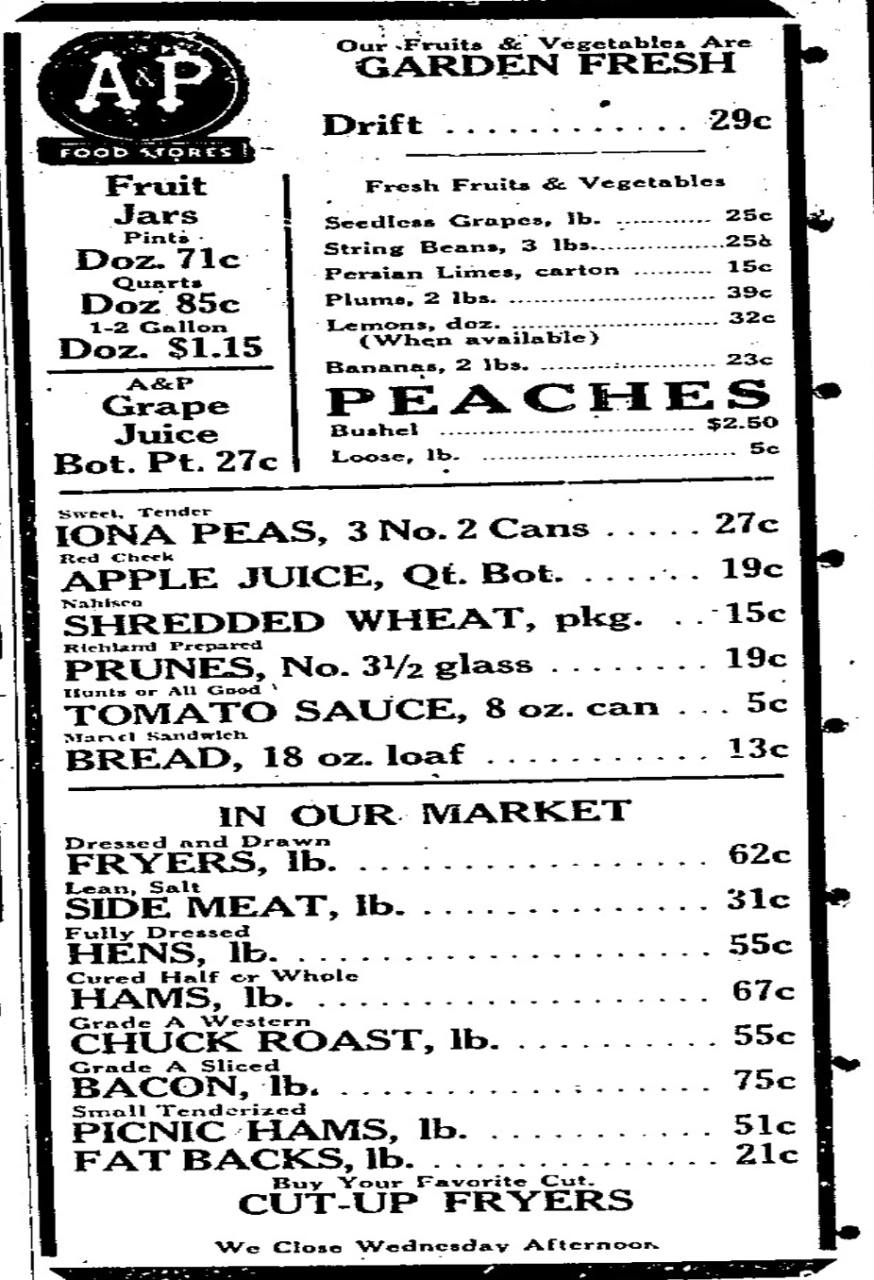
Greenville Daily Reflector July 25, 1947